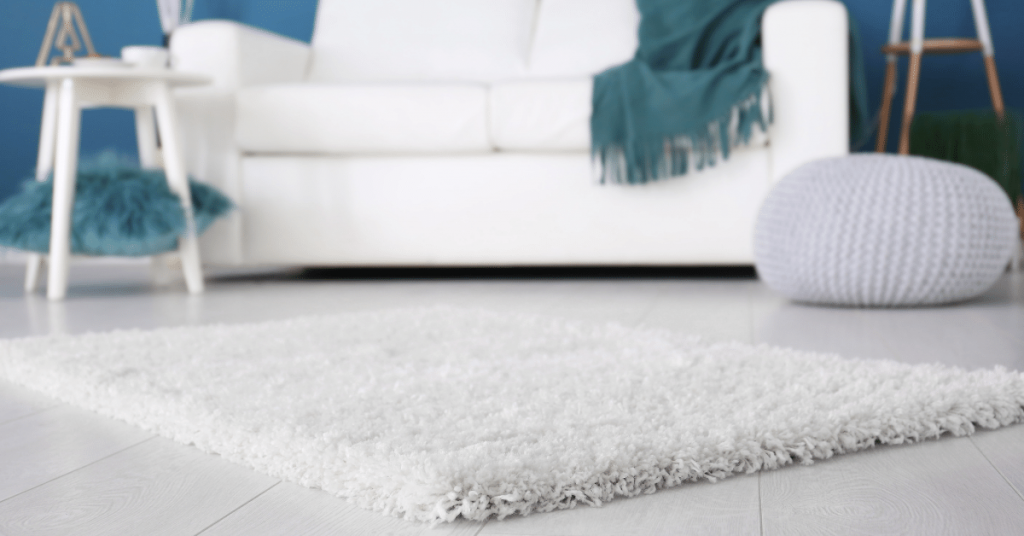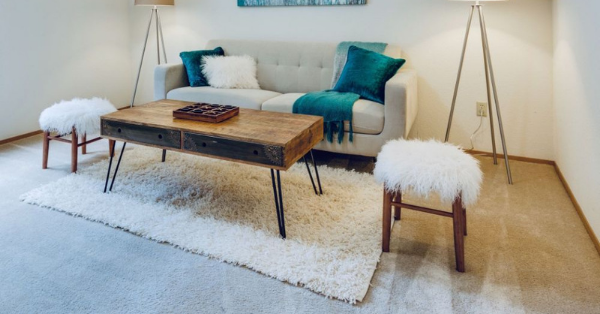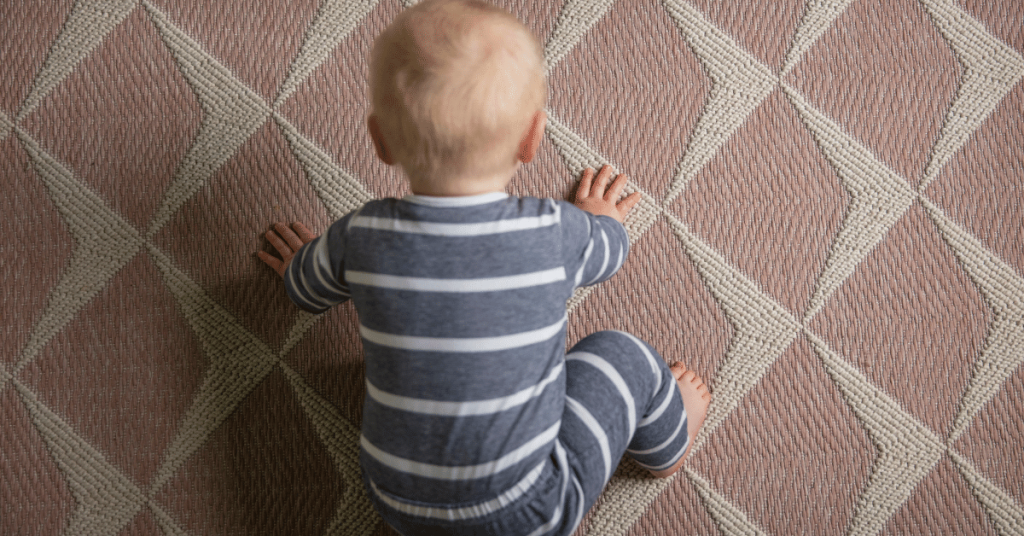Is anyone in your home a victim of allergic conditions? If the answer is yes, you must spare no effort to make the home safer for them. Reducing irritants indoors is crucial to prevent their distressing immune responses. After all, it makes a positive impact on the wellbeing of your household. Perhaps you have heard that a wool rug can prevent allergies, but you aren’t so sure if that is true.
A wool rug will generally not cause any allergies because of it’s hypoallergenic qualities. With a wool rug you don’t have to worry too much about dust mites and bacteria because it acts like a natural filter absorbing them. It can even absorb volatile organic compounds. That’s why wool carpets are consider the best to improve the indoor air quality.

Let’s take a look at how rugs may or may not affect allergies.
Carpets and Allergies
Carpets can be home to dust mites, pet dander, mold spores, and other allergens. Sometimes particles that were absorbed by the fibers are later emitted back in the air.
But is that true for all rugs?
No. It’s almost always the case with polyester rugs that often emit volatile organic compounds. But some other rugs are perfectly safe.
What rug materials can cause allergies?
All synthetic carpet materials (like nylon, polyester, and polyurethane) release volatile organic compounds and thus, trigger allergies. That’s why we’d never recommend them to someone suffering from allergies or with kids in the house. .
This is true especially for babies. If you have babies in the house (or someone with a baby visits often), I would strongly encourage you to read the following post:
Are Polyester Rugs Safe for Babies? You must read this!
Your newborn brings endless blessings and undeniable bliss to your home. Read this post to learn whether a polyester rug is safe for your beloved baby.
But since it’s wool you wanted to know about, let’s take a look at the properties that make wool an allergen-free material.

It is vital to comprehend that there are many types of carpet fibers, each displaying different behaviors. Let’s zero in on the properties of wool to deduce whether it causes allergies or not.
Properties of Wool
Wool is a unique natural fiber that is harvestable through the shearing of animals. This process is vital for the hygiene of the sheep, and simultaneously allows the collection of wool. Since the animal can naturally grow back fleece, the material qualifies as a renewable resource.
Wool is an absolute favorite of the public and has been in persistent use for centuries. Moreover, it is associated with luxury making it a highly desirable fabric.
Let’s dive into the specific properties of wool.
Hydrophobic Exterior, Hygroscopic Interior
It is peculiar how wool can both hold and repel water molecules.
Wool has a fascinating behavior that allows it to trap damaging air pollutants. The interior of this material is hygroscopic, while the exterior of this material is hydrophobic. In other words, if you touch a woolen material exposed to some humidity, it will feel dry because it externally repels moisture. However, internally it can hold up water molecules effortlessly.
Another intriguing behavior of wool is that it can absorb harmful gases or volatile organic compounds. Greater exposure to these substances may trigger an immune response. Since wool readily absorbs such allergens, there are lesser left in the atmosphere. Therefore, the presence of this natural fiber in the atmosphere can reduce allergies.
Isn’t it amazing that a wool rug can impact the level of allergy-triggering substances in your home?
Hypoallergenic Nature
If you study the behavior of wool, you would know it is unlikely to cause any allergic reaction. If properly maintained, this natural material prevents the growth of bacteria and mold.
Dust mites are microscopic pests that live in house dust. They are even not a millimeter long and are hence invisible to the naked eye. Wool, through its antimicrobial properties, inhibits the ability of dust mites to grow. Without easy access to skin flakes, dust mites in wool rugs will not be able to increase their population rapidly.

There is even science to prove the impact of wool rugs on dust mites. The German Applied and Experimental Allergy Research Association studied the interaction between wool, nylon, and dust mites. They found that wool carpets are more hostile to dust mite infestation than nylon ones. So you probably want to stick with wool!
According to the Asthma and Allergy Foundation of America, there are some efficient ways to tackle dust mites. Firstly, avoiding wall-to-wall carpeting and having floor coverings with a short pile is a must. Secondly, one may wash rugs whenever possible.
Easy to Clean
Individuals prone to allergies need a clean and hygienic environment.
PRO TIP
CLEAN YOUR WOOL CARPETS EVERY WEEK WITH A HEPA-CERTIFIED VACUUM.
High-efficiency particulate air (HEPA) filters can suck in allergens with high precision. Not only is this more hygienic for the household, but it will also increase the carpet’s lifespan.
Did you know wool isn’t as challenging to clean as popularly believed? Wool tends to release soil particles about 25 percent more quickly than its synthetic counterparts. Although it may require some effort, it is not impossible to reduce the dirt buildup in this natural fiber.
Frequent vacuuming in wool rugs, especially those placed in high-traffic areas, is necessary. It will help remove fine dust particles and other contaminants.
Modern vacuums are efficient enough to suction up tiny allergy-inducing substances. These machines are vital for the maintenance of wool rugs. Therefore, you need to ensure that you keep them in sound mechanical condition.

If you spill something on a woolen product, it can be easily cleaned with a cloth. After all, the fibers resist spills due to their hydrophobic nature. This nature doesn’t allow the liquid to seep in the tissues at once, giving you a window of opportunity to take action. When you see any spill on a wool carpet, take prompt action and wipe it away.
PRO TIP
CONSIDER PROFESSIONAL HOT WATER EXTRACTION FOR YOUR FLOOR COVERINGS ANNUALLY
Deep-cleaning your carpet and rug is crucial for the complete eradication of microbes or allergens that survived the vacuum. Going by this route ensures a longer lifespan for the fibers. Over time rugs may start appearing dull; however, professional deep cleaning will restore the rug’s appearance.
You can add years to the life of your rug if you properly take care of it.
Maintenance
While most fibers are minuscule enough to act as irritants, wool is not.
As soon as an irritant enters your respiratory tract, it may trigger an abnormal reaction, which includes inflammation. However, if a strand of the fiber isn’t inhalable, it poses no threat to the immune system.
Just because most carpets cause a harsh allergic reaction to occur, that doesn’t mean the same will happen with wool.
Wool fibers are generally too thick and long to become an issue for your immune system. They are not inhalable due to their size. This facet of this fiber impedes their ability to behave like an irritant. In other words, wool is unable to induce an allergic reaction because they aren’t the right size to do so.
Is Wool Bad for People With Allergies?
Without a doubt, wool rugs are not bad for people with allergic conditions. If properly maintained, floor coverings made with this material can discourage the growth of both bacteria and dust mites. Moreover, they also absorb contaminants in the air, thereby reducing the likelihood of the immune system to get triggered.

Wool has traditionally been associated with luxury. This expensive natural fiber is the perfect raw material for floor coverings. Not only is it soft and pleasing to touch, but it is also practical in deterring allergic reactions. Therefore, it makes sense to pay a little extra for this miraculous material.
Sensitivity to house dust causes vulnerable people to have a distressful immune reaction. However, the use of a hypoallergenic material like wool will help reduce the exposure of such contaminants in the environment.
Conclusion
This is what you should take home with you… wool doesn’t cause allergic reactions, but may even prevent them. If you’re looking to allergy-proof your home, wool rugs will become your best friends. This natural fiber is hypoallergenic and discourages the growth of bacteria and dust mites.
If you’re on the market for a wool rug, I would strongly encourage you to visit our post on Rug Shops you should Totally Check out!. I’m sure you’ll find a lot of beautiful wool rugs for you home!

